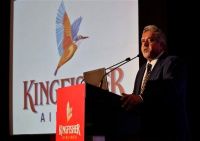
The color of Kingfisher is now truly red. Liquor Barron- Vijay Mallya promoted Kingfisher Airlines (KFA) is in serious financial trouble and the situation is worsening with each quarterly report. Mallya is often described as the Indian Richard Branson, but he may now get a rather unpleasant description of producing one of India’s biggest corporate failures. Â Kingfisher’s annual loss is expected to cross Rs 1500 crore this fiscal year. Already the company’s debt is close to Rs 8000 crores. The leader of the consortium of lenders to Kingfisher- State Bank of India already declared KFA as an NPA (Non Performing Asset or bad debt).
                      Over the last one year, the lenders to both Kingfisher and Air India are struggling to remain steady because the huge size of NPAs caused by these two. The two firms together have a debt of nearly Rs 27000 crores to seventeen banks. If these companies fail to restructure their debt, the lender banks may land in financial trouble. So it is better to restructure the debt of the borrower, or otherwise, the government will have to bailout the lenders, using tax payer’s money.
           KFA’s position as described is not unique for the industry. State run Air India is one of the largest indebted entities with a debt of around fifty thousand crores. Air India recently was managed to secure a debt restructuring package with its lenders. The public sector company got the benefit of sovereign guarantee (government support) to convert its Rs 18000 crore debt to non-convertible bonds. For Air India, the lenders became calm only because of the fact that the company is a government owned one.
           Debt restructuring to a debt- ridden company is a very risky situation for the loan giving banks. The RBI follows a strict provisioning norm for banks in the country. This requires that if a bank has an NPA or aims to give loans to an indebted company like the Kingfisher, it has to set aside (provide) at least 75% equivalent of the loans as a cover. This means that the bank can give that much amount less loans to other parties. So the banks in general are reluctant to give loans to Kingfisher. In the case of Air India, Rs 18000 crore restructuring was not difficult because the government provided guarantee to the amount. In the financial industry if a loan is guaranteed by the government, its risk weight is zero. So, in essence, there is no need to set aside provisioning amount even if Air India’s debt is bigger.
           KFA’s woes are bigger than the debt figures shows. The company can’t find even the amount to give salary to its employees and is cutting operations quickly. This indeed reveals the emergency nature of the situation. The government now can’t adopt inaction. It is to be seen whether the government is letting the company gradually to default. If it is the strategy, the government is responsible as a policy designer to allow some other entity to take over the Kingfisher at a fair price. Another policy option for the government is to allow higher participation for foreign firms, say to enhance FDI limit to 49% in the aviation industry. This will enable Kingfisher to find a foreign strategic investor to add funds to it. Definitely, foreign firms like the Singapore Airlines are awaiting this opportunity. Anyway, the Kingfisher’s saga is a lesson for the corporate sector as well as for the lenders in the financial sector.Â










